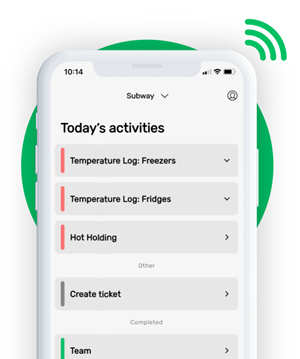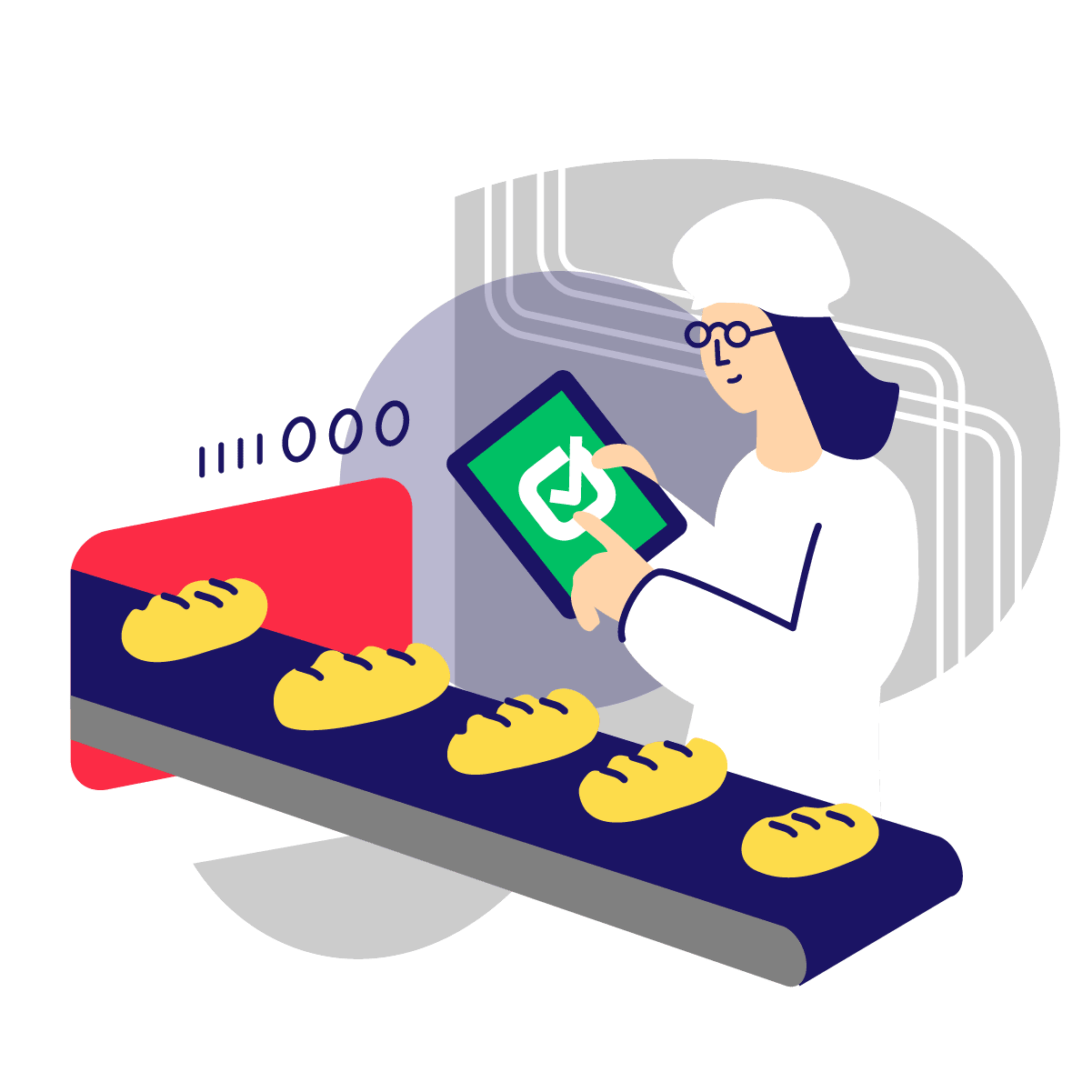RESTAURANT MAINTENANCE CHECKLIST | FREE DOWNLOAD
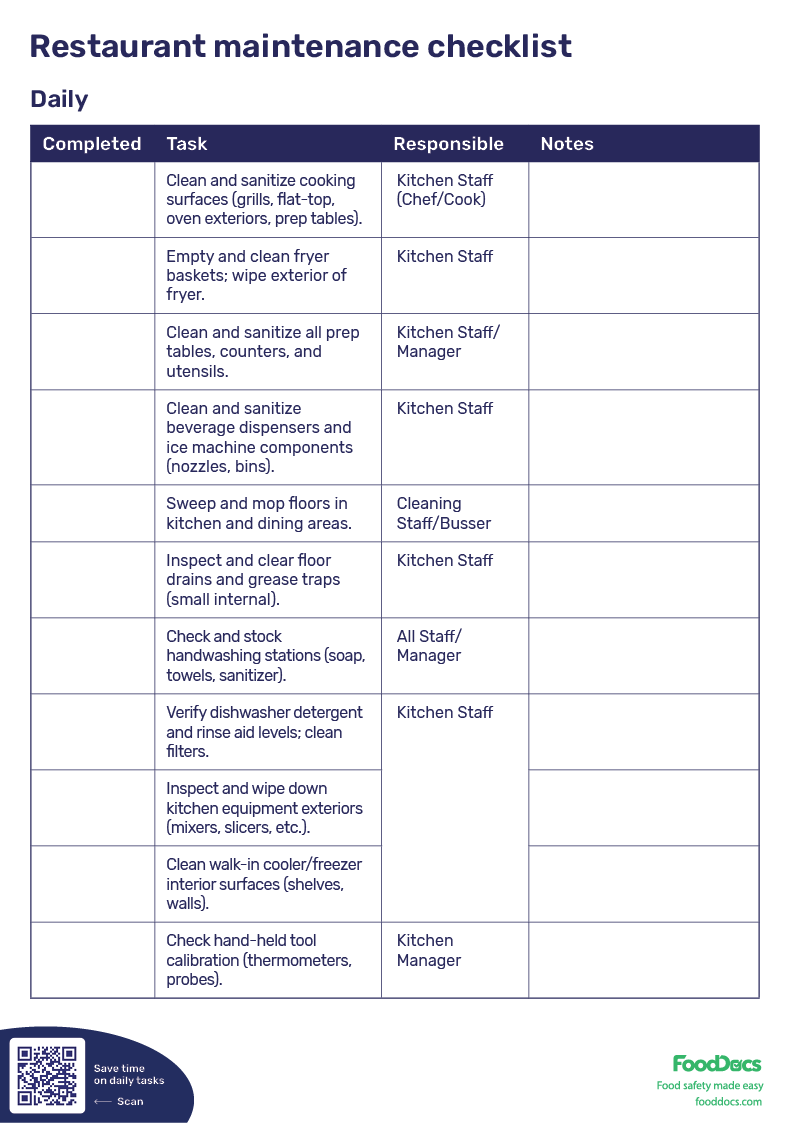



This is how our Digital Food Safety platform saves 20% of your time on daily tasks:
- Get upcoming task notifications
- Add data into the app
- Check the status of tasks in real-time

When food safety was still handled on paper, I typically spent a couple of hours per day getting the papers and going around checking or completing tasks… Now I can sit down and it's just all there in one place. It takes me 5-10 minutes.
Ruth B.
Store Manager
Keeping a restaurant running smoothly involves so much more than great food and service. Restaurant management requires diligent maintenance of kitchen equipment and facilities. A restaurant maintenance checklist is a practical tool to ensure nothing falls through the cracks.
Following a preventive maintenance plan will help enable restaurant managers, chefs, and food handlers to prevent costly breakdowns, uphold food safety standards, and extend the lifespan of their equipment, brick and mortar facilities, and more.
Below we’ll explain what restaurant preventive maintenance is, why it’s important, and provide a comprehensive restaurant preventive maintenance checklist. We’ll also share best practices to help you implement maintenance routines effectively, ensuring your restaurant stays safe, compliant, and efficient.
Key takeaways
-
Preventive maintenance is essential for keeping restaurant equipment running safely, efficiently, and in compliance with food safety standards.
-
A structured restaurant maintenance checklist, organized by daily, weekly, monthly, and annual tasks, helps prevent costly breakdowns and health code violations.
-
Daily cleaning and inspections, including sanitizing surfaces and checking refrigerator temperatures, are foundational to a safe and hygienic kitchen.
-
Weekly and monthly deep-cleaning tasks like descaling equipment, inspecting gaskets, and cleaning hood filters reduce fire risk and extend appliance life.
-
Annual professional inspections, including HVAC servicing and fire suppression certification, ensure regulatory compliance and operational reliability.
-
Assigning clear responsibilities for maintenance tasks increases accountability and ensures that no critical item is overlooked.
-
Regular equipment calibration and documentation are critical for food safety compliance and accurate temperature control.
-
Front-of-house and facility areas also require routine maintenance to ensure customer safety and uphold brand standards.
-
A successful maintenance program is one that is proactive, documented, and consistently executed by trained staff across all restaurant locations.
-
Digital tools such as FoodDocs are great for food safety monitoring and preventive maintenance checklists. They're especially useful for multi-location restaurants.
What is restaurant preventive maintenance?
Restaurant preventive maintenance refers to regular, scheduled inspections, cleaning, and repairs of kitchen equipment and facilities to prevent unexpected failures. In a busy foodservice environment, this means routinely checking everything from your HVAC system to cooking appliances like ovens, fryers, refrigerators, and ice machines.
The goal is to fix minor issues before they escalate into major problems that could halt operations. Preventive maintenance typically involves tasks such as equipment cleaning, lubrication of moving parts, replacing worn components, and calibration of thermostats or sensors.
If you're being proactive, it's much easier to ensure your restaurant's systems are working within proper specifications and avoid unplanned downtime. That's why we encourage preventive maintenance in restaurants: it's a proactive approach to keep the kitchen and facility in top shape, rather than reacting only when something breaks.

Why is preventive maintenance important for restaurants?
Neglecting maintenance can lead to safety hazards, health code violations, and expensive emergency repairs. Here are some key reasons why a preventive maintenance program is crucial in restaurants:
- Ensure safety and hygiene: Faulty equipment can create dangerous situations (for example, a grease-clogged vent hood could cause a fire). The most common cause of fires in restaurants is equipment breakdown.
Proper maintenance, like cleaning grease filters and servicing gas lines, reduces these risks and helps maintain a safe, sanitary environment for staff and customers. Well-maintained refrigeration and cooking equipment also keep food at safe temperatures, supporting restaurant food safety compliance. - Avoid costly breakdowns: Regular upkeep saves money in the long run. By fixing small issues early (such as replacing a worn oven gasket or a frayed fan belt), you prevent catastrophic equipment failures that result in high repair bills or sudden replacement costs.
As industry experts note, proactive regular maintenance results in fewer breakdowns and lower repair expenses while minimizing downtime. It’s an investment that pays off by keeping your kitchen running during peak hours without disruption. - Extend equipment lifespan: Commercial kitchen equipment is expensive. Taking care of appliances through routine cleaning, tune-ups, and part replacements helps them last longer.
Regularly descaling your coffee machine or cleaning your refrigerator’s condenser coils can add years to their service life. You’ll get the most out of your capital investments and won’t have to replace equipment as frequently. - Improve operational efficiency: When all equipment is functioning optimally, your kitchen operates more efficiently. Ovens heat evenly, fryers maintain temperature, and refrigerators stay cold, which means food is prepared consistently and on time.
This reduces delays in service and keeps your staff productive. Efficient equipment also uses less energy (lower utility bills) and performs better, contributing to smooth operations day-to-day. - Maintain compliance and reputation: Health inspectors and safety auditors expect to see that a restaurant is well-maintained. Broken or dirty equipment can lead to health code violations, fines, or even temporary closures. For example, a refrigerator not holding the proper temperature could result in spoiled food and a critical violation.
Doing this will help ensure all cleaning and upkeep tasks like grease trap cleaning and pest control are done regularly, which helps you ace restaurant health inspections. A clean, well-kept kitchen also makes a positive impression on inspectors and upholds your restaurant’s reputation for quality and safety.

Restaurant preventive maintenance checklist: daily, weekly, monthly, annual Tasks
To make your restaurant's preventive maintenance efforts manageable, it’s best to break down tasks by frequency. Organizing maintenance into daily, weekly, monthly, and annual duties ensures that critical items are checked regularly.
Below is a general restaurant preventive maintenance checklist covering what tasks to do and how often:
Daily maintenance tasks
To be done every day, often at closing or before opening:
- Clean and sanitize food-contact surfaces and equipment: Properly wipe down prep tables, cutting boards, line equipment, and countertops. Clean grill tops, griddles, and range surfaces to remove food debris and grease. This prevents buildup that can damage equipment or cause off flavors.
- Sweep and mop floors; wipe up spills: Maintain clean floors in the kitchen and dining areas to prevent slips and pest attraction. Pay special attention under heavy equipment and in walk-in units for any spills.
- Empty and clean drip trays and grease catchers: For example, empty the flat-top grill grease tray and clean fryers’ crumb catchers. This avoids overflow and reduces fire risk. (Get your free, complete Restaurant Fire Inspection Checklist.)
- Check temperatures of refrigerators and freezers: Ensure coolers are holding proper temperature (usually 4°C/40°F or below for fridges, -18°C/0°F for freezers). Log the temperatures in a fridge temperature log. If anything is above the safe range, investigate and correct it.
- Inspect equipment for obvious issues: Do a quick visual once-over of key equipment each day. Make sure gas burners ignite correctly, oven and fridge doors seal tightly, and no unusual noises or leaks are present. Early detection of problems (like a torn gasket or flickering hood light) means you can schedule potentially costly repairs before it worsens.

Weekly maintenance tasks
Done once a week, for deeper cleaning and inspection:
- Deep clean cooking equipment: Once a week, give a thorough cleaning to major appliances. For example, clean the oven interior and racks, de-grease the stovetop and grill, and boil out deep fryers (drain old oil and scrub the fry pot). Clean or change fryer oil filters if your fryer has an oil filtration system. This not only maintains food quality but also prevents grease fires.
- Clean and sanitize the ice machine and dishwasher: Follow manufacturer guidelines to clean your ice chute and ice maker (removing any slime or scale) and run a deliming cycle on the dishwasher. This keeps these units sanitary and functioning efficiently.
- Check refrigerator and freezer gaskets: Inspect door seals on all coolers for cracks and other signs of wear. Wipe them clean to ensure a good seal. Replace any damaged gaskets promptly to avoid cold air leakage.
- Clean exhaust hood filters: If your kitchen has a ventilation hood with removable grease filters, take them out weekly to clean them (soaking in degreaser or running through the dishwasher if allowed). Clean filters improve airflow and reduce fire hazard.
- Inspect plumbing and sinks: Look under sinks and around appliances for any small leaks or drainage issues once a week. For example, verify that sink traps and floor drains are not clogged. Early plumbing fixes can prevent water damage or slip hazards in the kitchen.

Monthly maintenance tasks
Every 1 to 4 weeks, schedule these larger upkeep items:
- Inspect and service HVAC and refrigeration systems: Clean or replace HVAC air filters at least monthly to keep proper airflow. Check refrigerator condenser coils for dust and clean them gently (unplug unit first) to maintain cooling efficiency. Ensure the walk-in cooler’s evaporator coils are clean and free of ice. Consider scheduling a professional HVAC inspection quarterly if possible, or at minimum annually, to keep your heating and cooling running optimally.
- Deep clean grease traps and drains: At least once a month (or as required by volume), have your kitchen’s grease trap pumped and cleaned to prevent clogs and odors. Also flush drains with hot water or enzyme solutions to reduce buildup. This maintenance avoids costly plumbing backups and complies with environmental regulations.
- Calibrate thermostats and kitchen equipment: Test the accuracy of oven thermostats and fridge thermometers monthly. Adjust calibration or schedule service if temperatures are off, to ensure food is cooked and stored safely. You might also calibrate food thermometers and scale calibrations on prep equipment periodically as part of quality control.
- Check fire safety equipment: Verify that fire extinguishers are easily accessible and have intact seals and proper pressure in the gauge (most extinguishers need a visual inspection monthly). If your kitchen has an automatic fire suppression system (hood system), do a quick visual check of nozzles and make sure inspection tags are up-to-date. Keep in mind: full service of fire systems is done yearly by professionals (as outlined in the annual tasks).
- Pest control inspection: Even if you have a contracted restaurant pest control service, do your own monthly walk-through. Check for signs of pests (droppings, chew marks) in dry storage, near doors, and in hidden corners. Make sure insect traps or rodent bait stations are in place and functioning. Promptly address any gaps or sanitation issues to keep pests out. Regular preventive treatments by a pest control professional should be scheduled (often monthly or quarterly) to avert infestations.

Annual (yearly) maintenance tasks
Scheduled once or twice per year, often by certified professionals:
- Comprehensive equipment tune-up: At least once a year, schedule a professional inspection and servicing for major equipment. This includes calibrating ovens, descaling steamers, tuning up refrigerators (checking refrigerant levels, compressor health), and checking gas appliances for proper combustion. A trained technician can perform deeper maintenance tasks that staff can’t, ensuring everything meets the manufacturer’s specifications.
- Service HVAC systems: Arrange for a licensed HVAC technician to inspect and service your heating, ventilation, and air conditioning units annually. They will check electrical connections, lubricate motors, clean coils deeply, and verify that the AC refrigerant and furnace are in good working order. Regular HVAC servicing prevents unexpected breakdowns during extreme summer or winter months and keeps the dining area comfortable year-round.
- Inspect electrical and gas systems: Have an electrician examine the restaurant’s panels and other electrical components, wiring, and outlets for any wear or hazards. Similarly, have a professional check gas lines and connections on stoves, ovens, and water heaters for safety (looking for leaks or weak hoses). These annual safety inspections help prevent fires and ensure compliance with local codes.
- Clean behind and inside large equipment: Even with daily cleanings, areas behind heavy equipment (ovens, fryers, refrigerators) collect grease and dust over time. Schedule a day to move these units (if possible) and clean underneath/behind them thoroughly. Vacuum refrigerator condenser units and clean kitchen hood ductwork (usually done by a hood cleaning service in compliance with fire codes). This yearly deep clean improves overall sanitation and removes potential fire fuel from hard-to-reach places.
- Test and recharge safety systems: Fire safety maintenance is critical. Each year, get your fire suppression system (over the range hood) professionally inspected and serviced as required by fire regulations (often every 6 months to a year). Ensure all fire extinguishers are professionally inspected and recharged/replaced if needed (usually tagged annually). Also test smoke detectors, alarm systems, and emergency lighting in your facility. Taking these steps guarantees that in an emergency, your safety devices will function properly.
- Facility maintenance check: Walk through your entire restaurant (front and back of house) with a maintenance eye. Look for any needed repairs in flooring (loose tiles, slippery spots), walls and ceilings (water stains could indicate leaks), and furniture (wobbly tables or ripped booth seats). Check that all lighting (inside and outside signage) is working and replace any burnt-out bulbs or fixtures. Maintaining the physical environment, including things like parking lot pavement to dining room paint, on at least an annual basis keeps your restaurant attractive and safe for guests and staff. Many establishments plan minor renovations or refreshes during a slow season each year to address these upkeep issues.

Following this restaurant maintenance task checklist daily, weekly, monthly, and annually will help you cover all the bases of restaurant maintenance — from kitchen equipment care to facility upkeep.
Every restaurant’s needs will vary slightly, but this framework ensures you schedule critical preventive maintenance at the right intervals. Feel free to customize the checklist for your operation, adding any unique equipment or local regulatory requirements.
For example, your restaurant maintenance checklist should include all cold-storage equipment and cooking appliances relevant to your kitchen, as well as any specialty equipment (e.g., espresso machines, bakery ovens, etc.) your establishment uses.
What are the best practices for restaurant preventive maintenance?
Having a restaurant checklist is the first step; ensuring it’s followed correctly is the next. Here are the top 10 restaurant preventive maintenance best practices to help you implement your maintenance program effectively:
1. Develop a maintenance schedule
Create a calendar (weekly/monthly planner) that outlines when each maintenance task should be done and who will do it. Assign daily tasks to opening or closing staff, schedule weekly tasks for a specific day (e.g., “Deep clean fryers every Monday”), and mark the dates for monthly and annual services.
Consistency is key because a fixed schedule makes preventive maintenance part of your routine rather than an afterthought. Many restaurants find it helpful to do major monthly tasks on the first Monday of the month, for instance, so they aren’t forgotten. Using a digital scheduler or maintenance software with reminders can be a big help here.
2. Assign responsibilities
Clearly designate team members responsible for each task or category of tasks. For example, the kitchen manager might be responsible for verifying all daily cleaning is done, while a head chef or a specific team member handles weekly equipment checks. If everyone knows what they own, there’s accountability. Divide tasks according to staff roles.
For example, chefs and line cooks can handle equipment cleaning, while a maintenance person or manager may handle regular inspections in the facility. For complex jobs (like electrical or HVAC checks), decide if you’ll use external professionals and mark those in your schedule.
3. Train your staff
A routine maintenance plan is only effective if your team knows how to do the tasks properly. Train kitchen staff on the correct cleaning procedures for each piece of equipment (e.g., how to safely dismantle the slicer for cleaning or how to clean condenser coils without damage). Ensure they understand the importance of these tasks for safety and efficiency and not just that “management is making them do extra work.”
Proper training also includes showing staff how to recognize warning signs of equipment issues (like frayed cords, unusual noises, or thermostat inconsistencies) so they can report them promptly. Regularly refresh training, especially when new equipment is introduced or new employees are onboarded.
4. Follow manufacturer guidelines
Always refer to the equipment’s user manual or manufacturer instructions for specific maintenance recommendations. Manufacturers provide details on how frequently to clean or service their equipment and what parts need regular replacement (for example, a blender’s blade assembly or a coffee machine’s water filter).
Adhering to these guidelines is considered a best practice to avoid voiding warranties and to keep equipment running as intended. Keep manuals in an accessible place (or digitally) for reference. If a piece of equipment is under warranty or service contract, make sure to schedule those service visits as recommended.
5. Keep a maintenance log
Document each maintenance activity. Use checklists for daily tasks that staff tick off and sign, and maintain a log (paper or digital) for weekly/monthly tasks noting the date and who performed it. This record-keeping serves two purposes: it helps managers verify that tasks are being completed, and it provides documentation in case of inspections or equipment warranty claims.
For instance, if a health inspector asks when the last restaurant's deep cleaning of the ice machine was done, you can show a log entry. Many modern Food Safety Management Systems and CMMS (Computerized Maintenance Management Systems) allow you to log tasks digitally and even upload photos as proof of completion.
6. Prioritize critical equipment
All maintenance is important, but give extra attention to the equipment that could cause the greatest disruption or danger if it fails. Identify your critical assets. Typically, for example, refrigeration (to protect food inventory), cooking equipment like ranges and fryers (to maintain service), and safety systems (fire suppression, alarms).
Make sure these items never get skipped. For example, if you’re in a very busy week and something must be postponed, it shouldn’t be the walk-in cooler check or cleaning the grease trap. Build redundancy or backup plans for key equipment if possible (e.g., having a spare fridge thermometer or a backup fryer on standby) to mitigate risk.
7. Be proactive with repairs
If during a routine check you find something’s off (e.g., an oven isn’t heating evenly or a sink is draining slowly), address it immediately. Don’t wait for the scheduled annual check if a problem has already surfaced. Preventive maintenance is about preventing issues, so fixing minor repairs sooner than later is part of the best practices.
Keep a log of repair needs that come up and track that they get resolved. It can be helpful to partner with reliable repair technicians who can come on short notice. Remember, a small investment in fixing a leak or replacing a seal now can save you from a major breakdown later.
8. Leverage technology and tools
Consider using digital tools or software to streamline your maintenance management. For example, a cloud-based app can send automatic reminders to staff for their tasks, or a sensor in a refrigerator can alert you if the temperature goes out of range. Many modern food businesses use preventive maintenance software (often part of an overall restaurant management or food safety system) to schedule tasks and keep records.
These systems can also generate checklists for staff daily via a tablet or phone, ensuring nothing is overlooked. Using such tools can improve consistency and take the guesswork out of when each task was last done. Even a simple shared calendar or task management tool can be effective for a single-location restaurant to remind the team about weekly and monthly duties.
9. Schedule professional maintenance
While much of preventive maintenance can be handled in-house, some tasks require expert attention. Don’t hesitate to schedule regular professional services for things like HVAC tuning, fire system inspections, deep fryer servicing, and hood cleanings in accordance with local fire codes.
Professional technicians have the expertise and equipment to do thorough checks (for example, pressure-testing gas lines or chemically descaling a boiler) that go beyond the scope of daily staff duties. They can also spot issues that your team might miss.
Establish relationships with service providers for critical areas (refrigeration, plumbing, ventilation, etc.) and have them perform preventive maintenance visits during off-peak hours. This partnership can save you time and ensure all work is done correctly and safely the first time.
10. Review and update your checklist
Finally, treat your maintenance checklist as a living document. Revisit it periodically (at least annually or whenever you introduce new equipment/menu processes) to see if tasks need to be added or frequencies adjusted. You might find that some equipment requires more frequent attention than initially planned, or new health regulations mandate an additional check.
Solicit feedback from your staff becauase they often have practical insights, like a particular cooler that gets dirty faster and needs cleaning more often. Adjust your preventive maintenance plan accordingly so it remains effective and relevant. An up-to-date checklist ensures you continue to reap the benefits of preventive maintenance without any blind spots.
Incorporating these best practices will help make your preventive maintenance program more robust and easier to manage. A well-trained team using a clear checklist and schedule will keep your restaurant in top condition, reducing the chance of equipment failures, improving efficiency, and ensuring safety. Remember that consistency is key: small daily and weekly efforts add up to a huge payoff in terms of reliability and cost savings over time.

Why should you download and use this restaurant maintenance checklist?
Here's why:
- Defined roles and record-keeping: Many lists omit who is responsible and how to document tasks. Leading advice urges creating an asset inventory and maintenance schedule, with specific assignments (e.g. chefs handle kitchen tasks, servers handle front-of-house). Detailed logging of completed tasks (dates, issues, parts used) is also stressed as essential.
- Scheduling and technology: Centrally managing maintenance across locations is crucial for chains. Modern platforms promote digital checklists and alerts to ensure consistency and 100% completion rate. Yet many guides do not cover using software or calendars for multi-unit scheduling.
- Safety and compliance checks: Routine fire-safety and code-compliance tasks are often missing. For instance, guidelines recommend testing fire suppression systems, checking backflow preventers, and replacing/examining extinguishers on schedule. Emergency plans and drills (fire, power outage, first aid) are also advised but rarely mentioned.
- Food safety integration: Preventive maintenance must tie into food safety. Tasks like calibrating thermometers, verifying sanitizer concentrations, and logging cooler temperatures are critical but frequently underplayed. Highlight daily temperature monitoring and seal inspections for refrigeration that should be explicitly included.
- Front‐of‐house and exterior: Maintenance isn’t just kitchen equipment. FOH areas need care too (e.g., checking dining-area lighting, furniture stability, restrooms, parking lots, and landscaping). These are often underdeveloped in checklists, yet they impact customer safety and comfort.
- Multi-location coordination: For restaurant chains, standardizing maintenance across all sites is key. Experts recommend centralized policies and reporting so every location meets the same standards. Most draft checklists don’t address how regional managers or corporate teams audit and reinforce schedules across branches.
In summary, aside from equipment cleaning routines, a comprehensive checklist for full-service, multi-site restaurants should specify roles, include documentation practices, cover safety/compliance tasks, and support coordinated execution. The table below integrates these elements into a practical preventive-maintenance routine.
Example of a preventive maintenance checklist
|
Task |
Frequency |
Responsible Party |
Notes |
|---|---|---|---|
|
Back-of-House (Kitchen) Daily: Clean and sanitize cooking surfaces (grills, flat-top, oven exteriors, prep tables). |
Daily |
Kitchen Staff (Chef/Cook) |
Prevents grease buildup and cross-contamination. Use approved cleaners. |
|
Empty and clean fryer baskets; wipe exterior of fryer. |
Daily |
Kitchen Staff |
Removes food debris and grease, maintaining fryer safety and food quality. |
|
Check and log refrigeration/freezer temperatures. |
Daily |
Kitchen Staff/Manager |
Ensures safe food storage; adjust controls if out of range. Record in log. |
|
Clean and sanitize all prep tables, counters, and utensils. |
Daily |
Kitchen Staff |
Maintains hygiene for food prep; prevents residue buildup. |
|
Clean and sanitize beverage dispensers and ice machine components (nozzles, bins). |
Daily |
Kitchen/Bar Staff |
Prevents bacterial contamination of drinks and ice. |
|
Sweep and mop floors in kitchen and dining areas. |
Daily |
Cleaning Staff/Busser |
Removes spills and debris to maintain cleanliness and prevent slips. |
|
Inspect and clear floor drains and grease traps (small internal). |
Daily |
Kitchen Staff |
Prevents clogs and odor issues; clean strainers. |
|
Check and stock handwashing stations (soap, towels, sanitizer). |
Daily |
All Staff/Manager |
Ensures staff hygiene compliance; restock consumables as needed. |
|
Verify dishwasher detergent and rinse aid levels; clean filters. |
Daily |
Kitchen Staff |
Ensures effective cleaning and sanitation of dishes. |
|
Inspect and wipe down kitchen equipment exteriors (mixers, slicers, etc.). |
Daily |
Kitchen Staff |
Removes food residue and grease from frequently touched surfaces. |
|
Clean walk-in cooler/freezer interior surfaces (shelves, walls). |
Daily |
Kitchen Staff |
Prevents mold and residue buildup; maintain sanitation. |
|
Check hand-held tool calibration (thermometers, probes). |
Daily |
Kitchen Manager |
Quickly test thermometers (ice/water or boiling tests) to ensure accuracy for food safety. |
|
Check lighting (bulbs and fixtures); note any burned-out bulbs. |
Daily |
Staff/Manager |
Ensures safe, well-lit work areas; schedule bulb replacement. |
|
Front-of-House & Dining Area Daily: Clean and sanitize high-touch surfaces (tables, chairs, door handles). |
Daily |
FOH Staff/Busser |
Maintains guest area cleanliness and hygiene. |
|
Check restrooms: clean surfaces, stock soap/towels, empty bins. |
Daily |
FOH Staff |
Ensures cleanliness and hygiene; restock cleaning supplies. |
|
Weekly: Deep clean oven interiors and remove racks. |
Weekly |
Kitchen Staff |
Removes baked-on buildup of food particles and carbon; preserves oven efficiency. |
|
Remove and soak hood/exhaust filters; clean hood interiors. |
Weekly |
Kitchen Staff |
Prevents grease buildup; reduces fire risk. |
|
Test and clean dishwasher interior (run cleaning cycle or descaler). |
Weekly |
Kitchen Staff |
Removes grease and scale; maintains machine performance. |
|
Replace burner drip trays and clean grates on stove and range. |
Weekly |
Kitchen Staff |
Prevents accumulation of food and grease under burners. |
|
Inspect refrigerator/freezer door gaskets; clean or replace as needed. |
Weekly |
Kitchen Staff |
Ensures proper seal to maintain temperatures. |
|
Clean condenser coils on refrigeration units (vacuum/brush). |
Weekly |
Kitchen Staff/Maintenance |
Improves cooling efficiency and reduces compressor strain. |
|
Deep clean and sanitize ice machine per manufacturer (if weekly recommended). |
Weekly |
Kitchen Staff/Contractor |
Keeps ice sanitary and machine operating well. |
|
Inspect and empty under-sink grease traps and floor drain strainers. |
Weekly |
Kitchen Staff |
Prevents kitchen clogs and sewer odors. |
|
Check HVAC intake/vent filters; clean or replace if dirty. |
Weekly |
Maintenance Staff |
Ensures good airflow and indoor air quality. |
|
Check and calibrate thermostat settings (HVAC, walk-ins) |
Weekly/Monthly |
Maintenance/Kitchen Manager |
Verify correct temperature setpoints; adjust for comfort and safety. |
|
Test lighting circuits (switches, GFCIs at sinks). |
Weekly |
Maintenance Staff |
Ensures electrical safety, especially near water sources. |
|
Monthly: Change HVAC system air filters. |
Monthly |
Maintenance Staff/Contractor |
Maintains airflow and system efficiency. |
|
Deep clean walk-in cooler/freezer (defrost if needed). |
Monthly |
Kitchen Staff/Contractor |
Prevents excessive ice buildup; check for mold/mildew. |
|
Sanitize entire ice machine (interior cleaning cycle). |
Monthly |
Kitchen Staff/Contractor |
Eliminates scale/slime; ensures safe ice. |
|
Inspect fire suppression hood system and extinguishers (verify gauges/tags). |
Monthly |
Maintenance/Contractor |
Confirms systems are ready; schedule service if out of date. |
|
Test emergency exit lights and alarm systems. |
Monthly |
Manager/Maintenance |
Ensures visibility and functionality for safety compliance. |
|
Inspect roof and gutters for leaks/debris. |
Monthly |
Maintenance/Contractor |
Prevents water damage; clean out leaves. |
|
Lubricate door hinges, wheels, and moving parts on equipment. |
Monthly |
Maintenance Staff |
Prevents squeaks and wear on doors and machinery. |
|
Deep clean behind all equipment (stoves, refrigerators). |
Monthly |
Kitchen Staff |
Removes hidden grease, dust, and debris. |
|
Review maintenance logs and update schedules; report any trends. |
Monthly |
Manager/Operations Team |
Ensures tasks are tracked; plan upcoming services. |
|
Inspect dining-area and exterior (patio, parking): clean debris, check lighting. |
Monthly |
Manager/Custodial |
Maintains guest safety and appearance. |
|
Replace water filters (coffee machines, beverage systems). |
Monthly |
Kitchen Staff |
Maintains water quality and machine performance. |
|
Quarterly: Professional inspection and cleaning of HVAC system. |
Quarterly |
HVAC Contractor |
Optimizes system health; identifies issues early. |
|
Professional hood and duct deep-clean service. |
Quarterly |
Kitchen Exhaust Contractor |
Required for fire safety; removes deep grease. |
|
Inspect refrigeration units (coils, refrigerant) by technician. |
Quarterly |
Refrigeration Technician |
Ensures cooling performance; top off refrigerant if needed. |
|
Calibrate kitchen thermometers and probes (ice-point/boil-point). |
Quarterly |
Kitchen Manager |
Verifies accuracy of temperature tools for food safety. |
|
Professional service grease traps/interceptors (external). |
Quarterly |
Plumbing Contractor |
Prevents sewer backups and health hazards. |
|
Inspect gas lines/connections on all cooking equipment. |
Quarterly |
Gas Service Technician |
Checks for leaks; ensures safe operation. |
|
Pest-control service (inside and outside, traps/bait stations). |
Quarterly |
Pest Control Contractor |
Prevents infestations of rodents/insects. |
|
Review and update SOPs for maintenance tasks. |
Quarterly |
Operations Manager |
Incorporate equipment changes and new regulations. |
|
Conduct cross-location maintenance audit. |
Quarterly |
Regional Manager |
Compare practices across sites to ensure consistency. |
|
Annual: Roof and exterior building inspection. |
Annually |
Building Inspector/Contractor |
Check roof, walls, foundation for repairs. |
|
Full fire-suppression system inspection and certification. |
Annually |
Fire Safety Inspector |
Meets local fire code requirements. |
|
Backflow preventer test and certification. |
Annually |
Plumbing Contractor |
Ensures water system safety and compliance. |
|
Comprehensive maintenance program review and budget planning. |
Annually |
Operations Manager |
Analyze past year’s logs; plan upgrades/replacements. |
|
Staff training refresh on equipment safety and maintenance procedures. |
Annually |
Manager/HR |
Reinforces proper maintenance techniques and safety. |
The goal is to optimize for success and stay consistent
Implementing a restaurant maintenance plan might feel like extra work, but it’s an investment in your business’s success. With a bit of organization and the right mindset, preventive maintenance becomes just another part of the daily routine (and one that greatly pays off by preventing disasters before they happen). Managers and chefs who champion regular maintenance set their teams up for smooth services and fewer emergencies. Plus, a well-maintained restaurant creates a better working environment for staff and a safer dining experience for customers.
Finally, always strive to foster a culture of proactive maintenance in your restaurant. Recognize and reward staff who consistently uphold maintenance standards, and remind everyone that taking care of equipment is taking care of the business. Doing so will minimize downtime, avoid hazards, and confidently sail through health inspections. Your kitchen will run like a well-oiled machine — literally and figuratively — delighting customers with reliable service and great food.
Stay safe, stay organized, and keep that checklist handy for daily reference. With these maintenance best practices in place, you can focus on what you do best: delivering excellent dining experiences, every single day.
How to monitor preventive restaurant maintenance checklists with food safety software
FoodDocs is a food safety management software built for restaurants, especially ones with multiple locations. You'll get helpful monitoring features that help with daily, monthly, and yearly tasks including:
Cleaning checklists to stay food safety compliant
Using our system, you can get automatically generated Cleaning Checklists. This checklist features key cleaning tasks for a restaurant business. You can also rearrange tasks and add a new category, such as the location of the set of tasks. Feel free to replace the words on the form when needed.
Help your team remember all essential cleaning tasks and their schedules to stay compliant with food safety regulations. Add or improve unique tasks to your checklist to tailor it better to your operations.
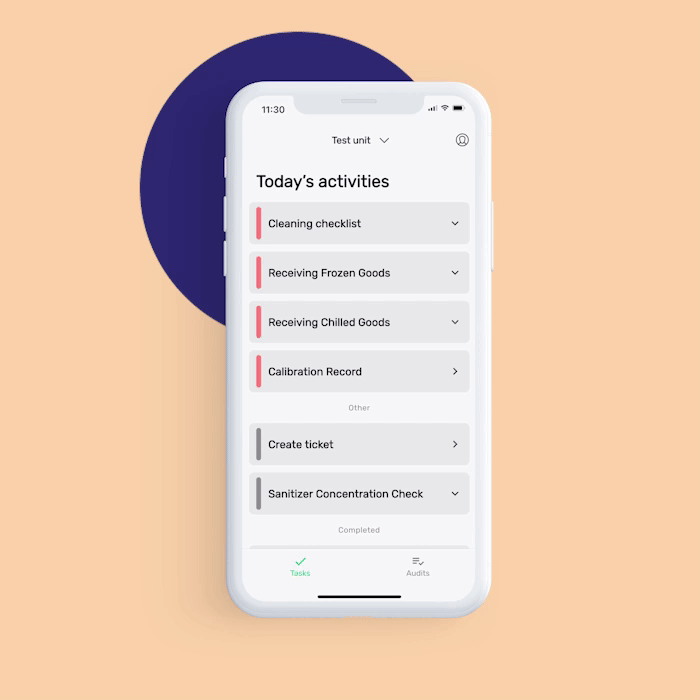
Thermometer calibration logs for accurate readings
Monitoring thermometer accuracy is a key part of any food safety plan. With FoodDocs, you can get automatically generated Thermometer Calibration Logs that help your team perform regular checks and keep all readings accurate. These logs are tailored to include essential calibration steps and can be adjusted based on your thermometer type and calibration method (e.g., ice point, boiling point, or using a certified reference thermometer).
Keep your equipment readings reliable and consistent across all locations. Add reminders for scheduled calibrations and set verification checkpoints so your staff knows when a thermometer needs adjusting or replacing. Maintain a solid record of calibration checks to support audits, inspections, and internal reviews.
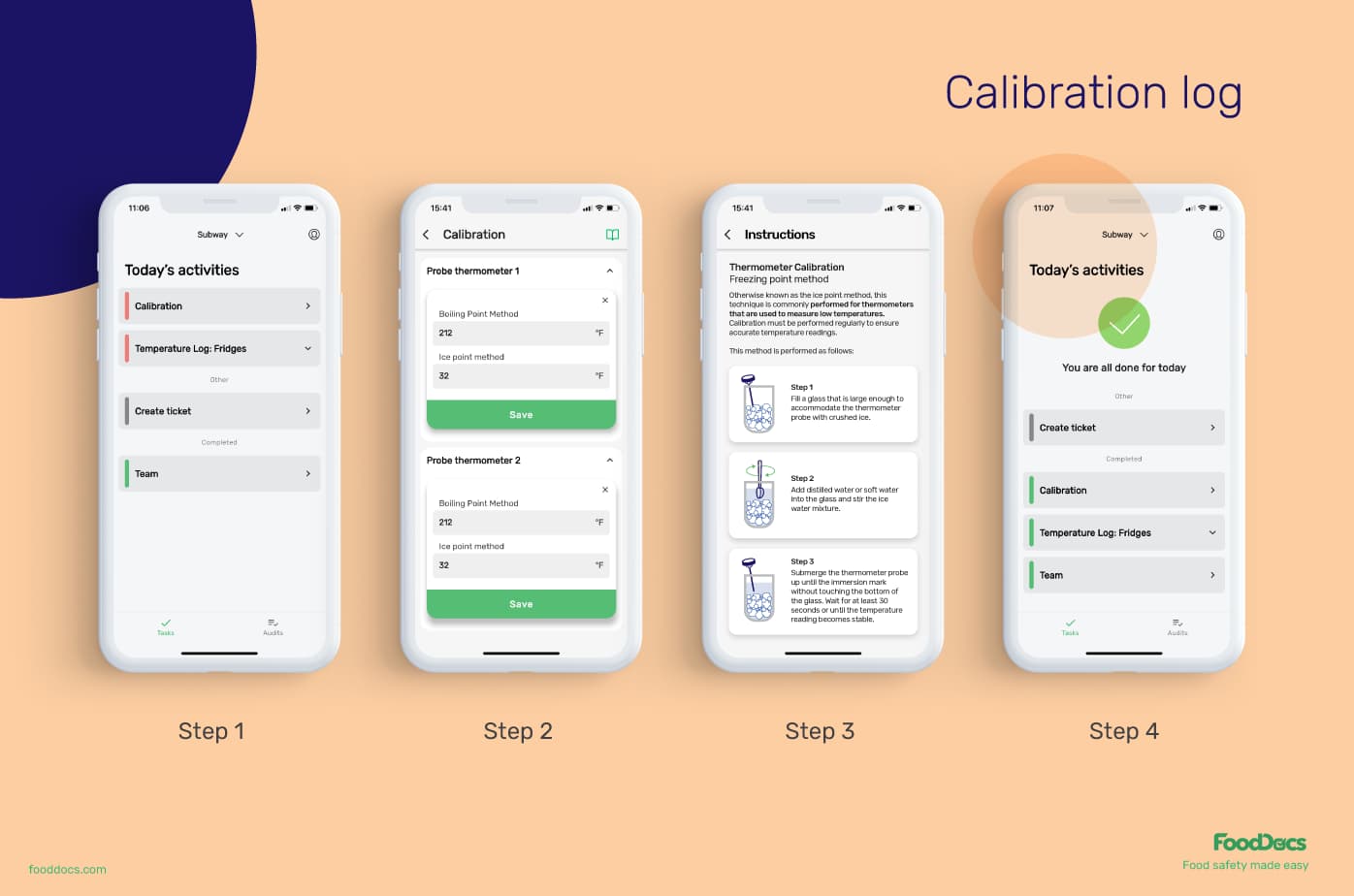
Step-by-step instructions to help perform tasks
In addition to the being fully customizable, you can get built-in step-by-step instructions for every automatically generated monitoring log. Use these instructions to guide kitchen staff and other food handlers on how to carry out any given task.
Ensure that your team knows how to clean surfaces properly and every corner of your business with these detailed instructions. In addition, you can also upload your own versions of instructions as images or videos.

Real-time overview to save time from supervision
To help you get a general understanding of your everyday progress, our digital software features a real-time dashboard. All your food safety operation progress is reflected through a central dashboard.
You can use this feature to save at least 20% of your time supervising every task you need to do and focus more on your business. The dashboard shows which areas need more attention so you can focus on those tasks. You can directly contact the involved food handlers and resolve any issues with cleaning and use the dashboard to verify cleaning tasks to ensure food safety compliance.
To get more essential features for your food safety management system, try our free 14-day free trial and start organizing your daily or monthly tasks with FoodDocs.
